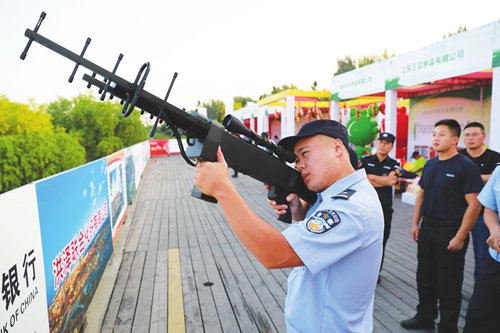
From the People's Daily app.
And this is Story in the Story.
Civilian and commercial drones used for aerial photography have become extremely popular in China after a boom in the industry, with one online flagship store of a leading Chinese drone brand selling thousands of drones monthly. With drones now coming at an affordable price, they are an essential piece of equipment for photographers.
But this has resulted in a range of security problems, as some drones fly over private or restricted areas without permission.
When a civilian drone flew illegally into Nanjing Lukou International Airport in East China's Jiangsu Province on April 4, 2017, 14 flights were affected, causing tremendous financial losses.
The potential danger caused by accidentally falling drones has also become a public concern, resulting in growing calls recently for laws and regulations to control drones.
Today's Story in the Story looks at the new rules for UAV flights and the development of counter-drone technology.

A police officer takes aim at a drone during the crab festival in Hongze Lake, Huai'an of East China's Jiangsu Province on September 8, 2018. (Photo: VCG)
The State Council and the Central Military Commission jointly released a draft of interim regulations on Unmanned Aerial Vehicles (UAV) on January 28, 2018, China's first state-level strategic deployment in terms of regulation and development of drones, according to the Xinhua News Agency.
The interim regulation places drones into five categories based on weight and speed: mini, light, small, medium and large. According to Dji, China's leading drone manufacturer, 90 percent of the drones available in the Chinese market are the light type.
According to the regulation, mini drones are allowed to fly at heights below 50 meters without permission except for airspace over and around restricted areas, airports, restricted military zones and dangerous areas. Light ones are allowed to fly in airspace lower than 120 meters.
In addition, national-level supervision and control platform is being considered to share information on civilian drones with public security departments. At the same time, a control and management system will be set up by the public security department.
On May 1, a regulation on drones will take effect in East China's Zhejiang Province.
The province adopted on June 1, 2017 a real-name registration method for users of drones that are heavier than 250 grams, according to the website of the Zhejiang provincial government.
One drone user, surnamed Weng, said that most operators are well aware of the no-fly zones in Wenzhou, Zhejiang, and tend to abide by the rules. Weng is also a member of the aerial photography association of Wenzhou, Zhejiang Province.
Weng said that some users still attempt to break the digital fence, noting that the attempt to hack the digital fence is wrong, and should be discouraged.
According to the regulation, individuals who remodel UAVs, sabotage built-in digital fences, or who fly drones in prohibited times and areas will be fined 1,000 to 5,000 yuan ($150-750).

Counter-drone devices are showcased at the 4th China (Beijing) Military and Civilian Integration Expo in July 2018. (Photo: VCG)
In additional to government regulations, several Chinese companies are also focused on developing counter-drone technology.
Based in Shanghai, Jianzhen Technology Company specializes in developing and producing low-altitude airspace security products.
"The basic working procedure of the C-UAV system is comprised of four steps: detection, recognition, following and handling," Shuai Bo, CEO of JianZhen Defense Technology (Shanghai) Co Ltd, told the Global Times.
"Through combined intelligent detection measures such as active radar, passive target detection, infrared and optical detections, drones ascending and flying in low-altitude airspace can be detected swiftly," said Shuai.
"The drone can be recognized on a cloud platform. We continuously follow and locate the drone, generating a real-time flight trajectory. Counter-drone devices and a drone navigation deception system will then be used to disrupt their communication. Finally, the drone will be shot down by a laser net," Shuai explained.
Shuai also told the Global Times that their products have also been successfully used in multiple major international events, such as the Shanghai Cooperation Organization Summit and the CCTV New Year's Gala.
Counter-drone devices are now available on e-commerce platforms. On one Chinese platform, hundreds of products with prices ranging from several thousand to half a million yuan are available.
Low-altitude airspace security products will also see rapid growth. The market capacity in China's low-altitude airspace management is estimated at the hundreds of billions of yuan, and the industry is currently undergoing a boom with an annual growth rate of 35 percent.
(Produced by Nancy Yan Xu, Chelle Wenqian Zeng, Lance Crayon, and Brian Lowe. Music by: bensound.com. Text from Global Times.)


